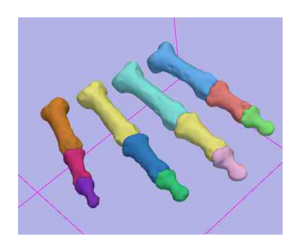Difference between revisions of "EM Segmentation For Orthopaedic Applications"
From NAMIC Wiki
(New page: '''Objective:''' * To utilize the Slicer3 Expectation Maximization Algorithm for segmentation of the phalanx bones of the hand. '''Progress:''' * We have utilized the Slicer2.7 EM Segme...) |
|||
| Line 26: | Line 26: | ||
'''Figures:''' | '''Figures:''' | ||
| − | [[Image: | + | [[Image:EM-Segment-Phalanx.png|left|thumb|300px|Surface models from EM Segmentation generated via Slicer3]] |
| − | [[Image: | + | [[Image:EM-Segment-Proximal.png|left|thumb|300px|Results of the EM Segmentation for the Proximal Pahalanx]] |
| − | |||
| − | |||
Revision as of 22:05, 29 October 2007
Home < EM Segmentation For Orthopaedic ApplicationsObjective:
- To utilize the Slicer3 Expectation Maximization Algorithm for segmentation of the phalanx bones of the hand.
Progress:
- We have utilized the Slicer2.7 EM Segmentation Module for segmentation of the phalanx bones
- Registration was performed outside of SLicer using ITK registration algorithms that are available in the IaFeMesh software. This includes Thin plate spline, B-Spline and rigid registration algorithms.
- Probability map information was created from a single subject used as the atlas image and filtered using a Gaussian filter.
- Initial evaluation has been carried out on five subjects that also had been segmented using manual segmentation
- Work is underway to develop a Slicer2.7 tutorial for this segmentation
To Do:
- Evaluate the Slicer3 EM Segmentation Module
- Update the the tutorial to support the Slicer3 Workflow
- Determine if registration tools in Slicer are adequate for this work.
Key Investigators:
- Iowa: Austin Ramme, Nicole Grosland, and Vincent Magnotta
Links:
Figures:

